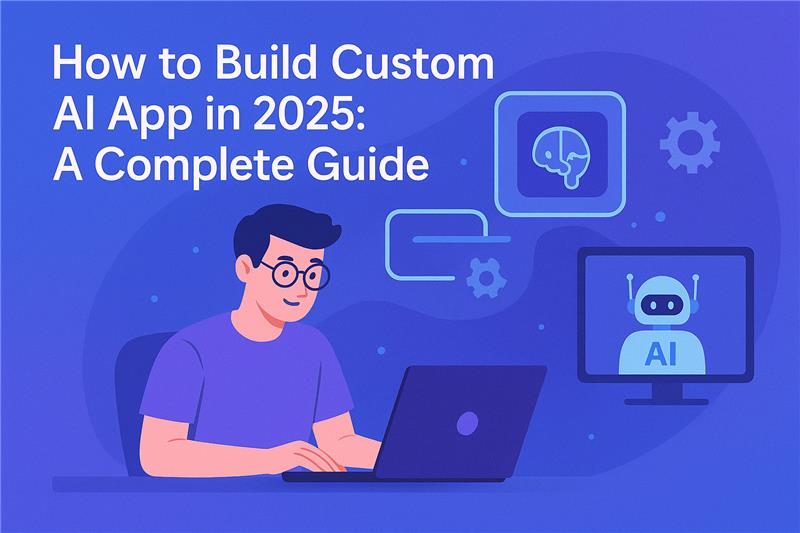
The world in 2025 is moving fast, and it’s smart. Everywhere you look, AI is reshaping how we live, work, shop, learn, and connect. But here’s the deal: AI isn’t just a buzzword anymore it’s the backbone of modern digital business. If you’re a company looking to grow, stand out, or even just keep up, having a custom AI app isn’t optional. It’s essential.
Table of Content
At Code Brew Labs, we’ve seen firsthand how the right AI solution can completely transform a business. We’ve worked with startups, enterprises, and everything in between helping them automate time-consuming tasks, make smarter decisions with their data, and deliver personalized experiences that make customers go “wow.”
The finest aspect? Building something powerful doesn’t require you to be a tech giant. Building your own AI software is now easier than ever because of platforms like OpenAI and Google Cloud, as well as an expanding ecosystem of accessible machine learning tools.
However, and this is crucial, off-the-shelf AI tools are limited in their capabilities. You need something that is customized, scalable, and intelligent enough to address your unique issues if you want to stand out in 2025. This is where working with a reputable AI app development and consulting firm, like us, can help.
Let’s take you step-by-step through the process of realizing your AI app idea.
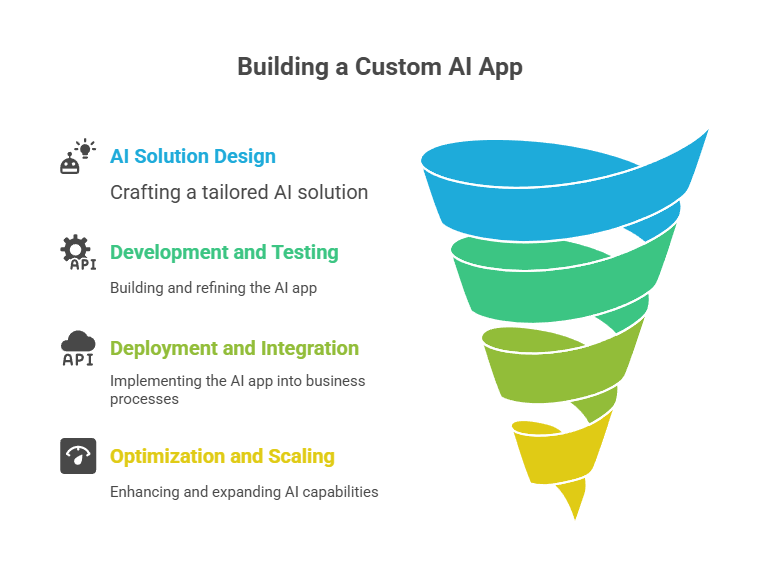
Imagine being able to predict customer needs, optimize supply chains, and automate customer support—before your competition even knows there’s a problem. That’s what a custom AI app can do. It becomes an intelligent layer across your business stack, learning from your users, adapting in real-time, and driving efficiency like never before.
The good news? You don’t have to be a Fortune 500 company to get started. Whether you’re a fast-growing startup or an enterprise looking to scale, this complete guide will walk you through the process, from idea to deployment.
Before you start coding, the first step is to clearly define why you want to build an AI app. What specific problem are you trying to solve? Is it to automate customer queries through an AI chatbot, optimize logistics using AI agents, or generate real-time content using generative AI?
Your problem statement should be outcome-focused. For example:
When you’re laser-focused on a specific goal, it becomes easier to build a solution that delivers measurable ROI.
Once the problem is defined, outline your success metrics. These could include performance benchmarks, user engagement targets, or backend processing speeds. Also, decide on the core capabilities your AI app must have—voice interaction, image recognition, real-time analytics, or multilingual support.
This is also where our AI consulting services help you clarify scope, establish feasibility, and define a roadmap. We assess your existing infrastructure, identify data sources, and advise on the best AI technologies to deploy, setting you up for long-term success.
AI is not one-size-fits-all. Choosing the right type of AI depends on your use case:
Each has unique strengths. A healthcare app may benefit from an AI agent that tracks symptoms and schedules appointments, while an e-commerce store could use a generative AI engine to write product descriptions on the fly.
Our AI integration experts help you combine these technologies for a seamless, intelligent user experience. For example, an app could use a chatbot interface powered by a generative AI engine that creates personalized answers in real-time.
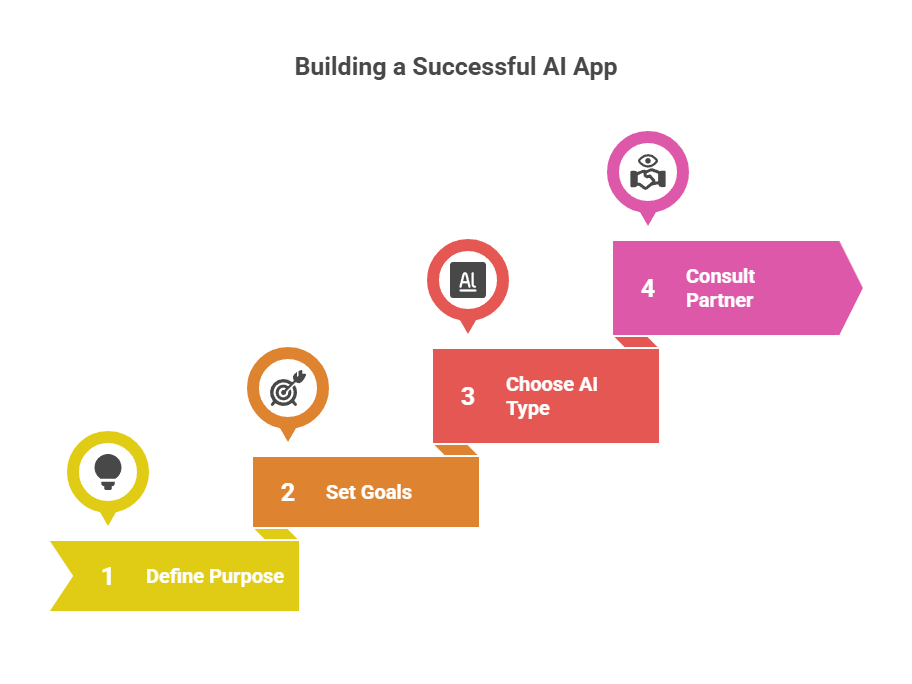
Building an AI app isn’t just about training a model it involves strategy, architecture, integration, and long-term scalability. Partnering with an experienced AI development company ensures you’re not reinventing the wheel or running into avoidable pitfalls.
At Code Brew Labs, we provide end-to-end AI solutions from ideation to deployment customized to your business needs. We bring:
AI success depends on strategy as much as code. That’s why we also offer AI consulting to align your AI app with your larger business goals. This includes:
Our consultants work alongside your in-house team or stakeholders to ensure every aspect of the build aligns with KPIs, tech stacks, and future scaling plans.
Garbage in, garbage out. That’s especially true in AI. Even the most powerful models can’t deliver results without high-quality, relevant, and structured data. Before development begins, your team needs to identify all available data sources—internal CRMs, third-party APIs, customer behavior logs, and more.
Data should be:
You may also need to enrich your data using public datasets, synthetic data generation, or paid datasets, depending on your niche.
We help startups and enterprises establish robust pipelines for data ingestion and storage, whether in cloud environments like AWS or hybrid local systems. Our AI integration specialists ensure seamless connection to your databases, APIs, and IoT systems where necessary.
Preprocessing is just as important—this includes:
Well-prepared data sets the foundation for a reliable, high-performing AI model.
Once your data is ready, it’s time to develop the AI model that will drive your app’s intelligence. There are generally two options:
We evaluate both options as part of our AI development services, helping you strike the perfect balance between speed, cost, and performance.
Once a model is selected, the next step is training. This involves feeding your dataset into the AI model so it can learn to make predictions or generate results. We focus on optimizing training accuracy without overfitting, ensuring that the model performs well not just on historical data, but also in real-world conditions.
Key stages include:
This is where the technical expertise of your AI partner shines. We use state-of-the-art techniques, including reinforcement learning, transfer learning, and ensemble modeling, to push performance to its limits.
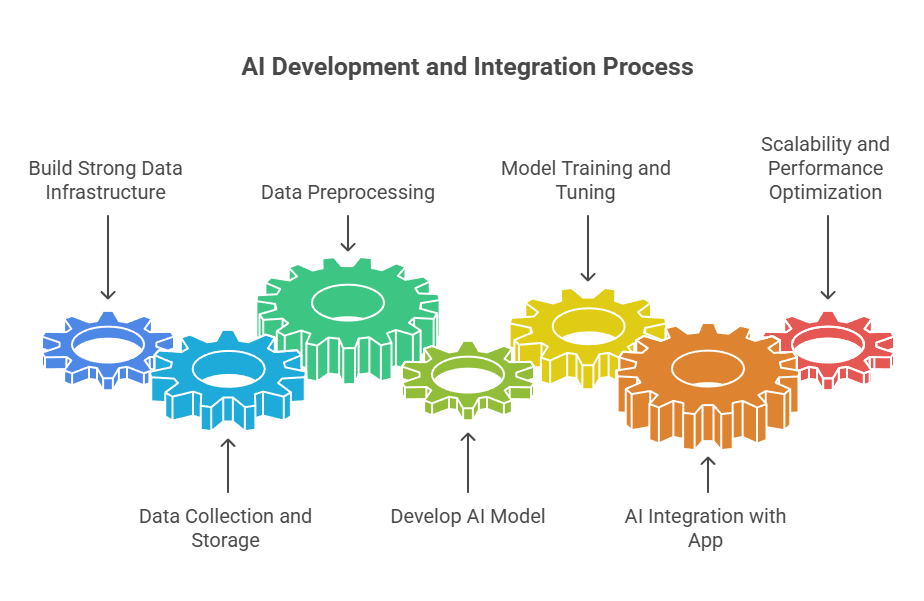
Now that your model is built and tested, it’s time to plug it into your application. Whether you’re adding AI features to an existing app or building something from scratch, integration is key.
Our AI integration services ensure your model communicates smoothly with your backend systems, databases, APIs, and frontend interfaces. We build robust, scalable pipelines that allow real-time or batch processing, depending on your needs.
Example integrations include:
A successful AI app must scale. Whether you’re serving hundreds or millions of users, performance needs to be consistent. We focus on:
Performance is constantly monitored for latency, throughput, and load handling. We use containerization (e.g., Docker) and orchestration (Kubernetes) to ensure uptime and reliability, even during traffic spikes.
User experience is everything, especially when AI is involved. If the interface doesn’t communicate the AI’s capabilities, users will be confused or frustrated. That’s why we design intuitive, human-friendly interfaces that make AI feel approachable, not intimidating.
For example:
We ensure users always feel in control, even when automation is driving the experience.
It’s important to strike the right balance between automation and human touch. Users should always be able to:
We incorporate UX best practices such as progress indicators, editable fields, undo buttons, and transparent messaging so that users feel empowered, not overwhelmed.
Our team collaborates with stakeholders during wireframing and prototyping to ensure the final product meets both business goals and user expectations.
No app goes live without rigorous testing, and AI apps require a unique QA process. Traditional testing ensures app functionality, while AI testing validates the intelligence and accuracy of the model itself.
We conduct:
Custom test cases are created for each AI function, and automated scripts are used to simulate real-user interactions.
AI has its risks—bias, misinformation, and privacy violations. That’s why our QA process includes:
As part of our AI consulting services, we also help businesses prepare documentation and compliance reports to ensure transparency and accountability.
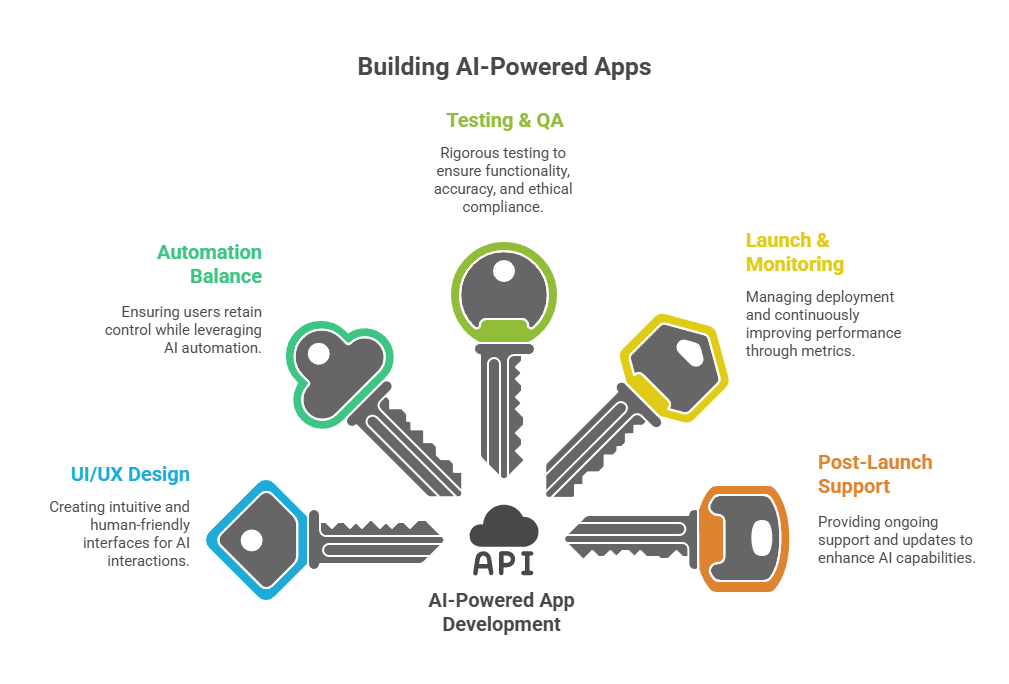
The big moment is here—your custom AI app is ready to launch. But a successful launch goes beyond hitting “deploy.” We manage:
Our team also implements fallback mechanisms so that if the AI fails or gives a wrong result, the app gracefully reverts to a human-in-the-loop workflow or logs the incident for review.
Post-launch, the focus shifts to performance monitoring. We track:
Real-time dashboards are created to help you visualize how your app is performing, and alerts are set up for anomalies or model drift. This ensures your AI app continues to deliver value long after launch.
AI doesn’t stop learning after launch, and neither should your app. One of the major advantages of custom AI applications is the ability to continuously improve their intelligence over time through retraining. As your app gathers new data, we help you refine and redeploy smarter versions of your AI models.
This includes:
With our ongoing support, your app won’t just work; it will evolve into a competitive advantage that gets smarter and more effective with time.
Post-launch success is often dependent on how well AI aligns with long-term strategy. That’s where our continuous AI consulting services come in. We help your leadership and product teams make data-backed decisions, identify new AI opportunities, and avoid potential risks.
Our support includes:
Think of us as your extended AI department offering both technical expertise and business foresight to ensure your AI app thrives in the real world.
Building a custom AI app in 2025 isn’t just a trend; it’s a transformational step toward future-proofing your business. Whether you’re streamlining operations, enhancing customer engagement, or unlocking new data-driven insights, a well-designed AI app can be your most powerful asset.
But success requires more than a clever idea. It demands the right strategy, tools, partners, and execution. At Code Brew Labs, we specialize in AI development, seamless AI integration, strategic AI consulting, and the deployment of intelligent systems like AI chatbots, AI agents, and generative AI platforms.
From discovery to deployment and everything in between, we’re your full-cycle partner for building smart, scalable, and secure AI apps that deliver real business impact. Let’s turn your vision into reality. Get in touch with our team today to start building your custom AI solution.
